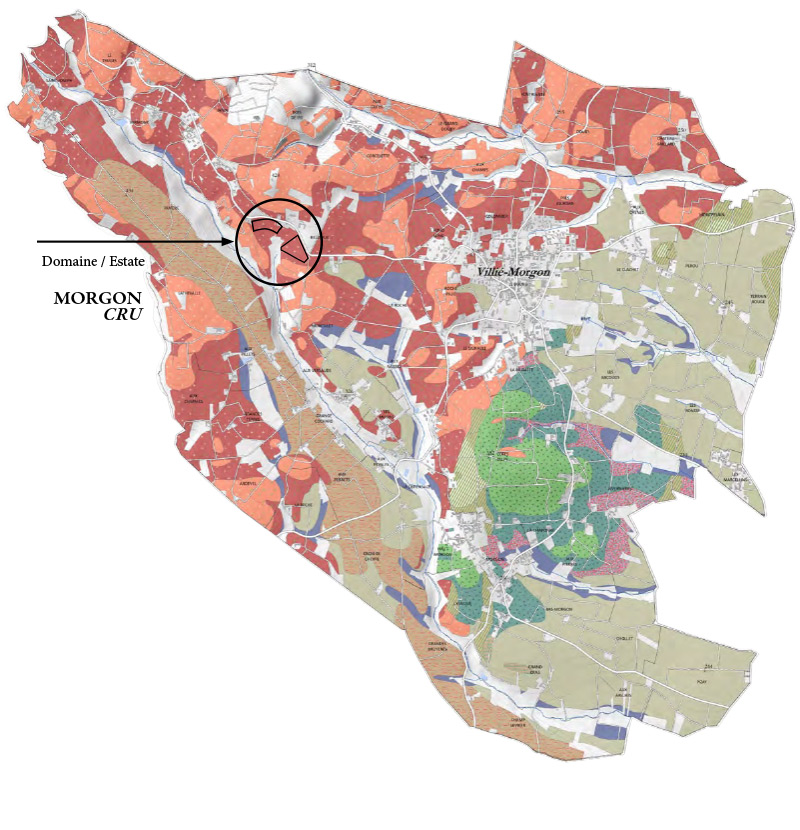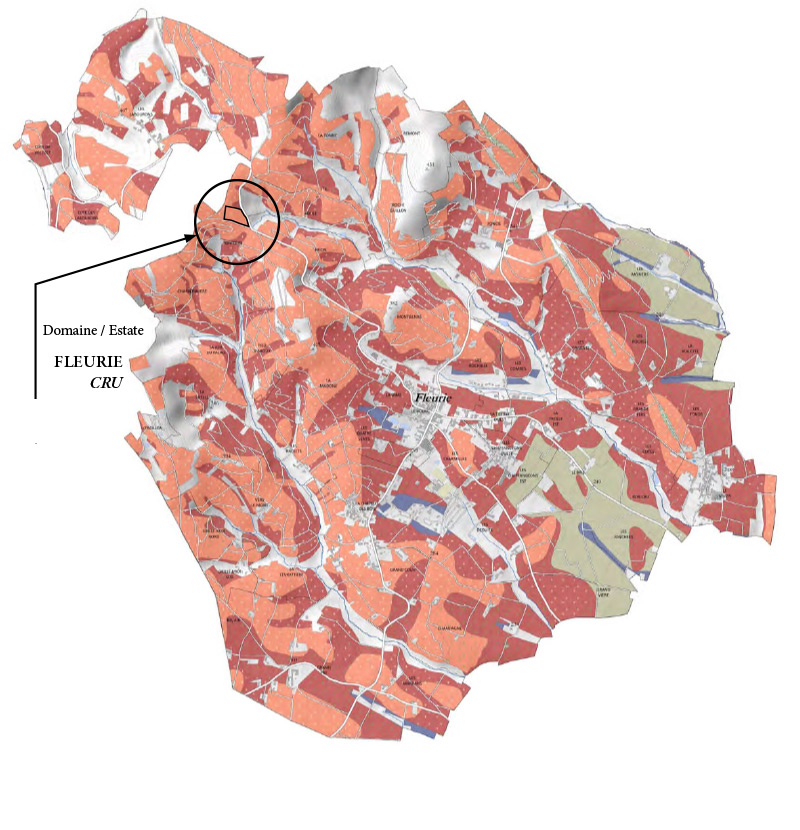France
Domaine Jonathan Pey
Morgon Cru “Bellevue” & Fleurie Cru “Fonfotin”
“Organically farmed, 70-year-old vines grown in steep, pink granite soils at over 460 meters (1,500’) altitude is where extraordinary wine happens.”
Jaw-Dropping History
Twenty centuries of winegrowing: Morgon and Fleurie's vineyard history dates to Roman times (~100BC) and by the 7th-10th century the vines were tended by Benedictine monks.
Morgon’s and Fleurie's prestigious Appellation d’Origine Controlée (AOC) and “Cru” status were conferred in 1936 by France's Institut Nationale d’Appellation d'Origine (INAO), the same year as Pauillac and Romaneé-Conti.
Morgon and Fleurie are very small appellations. At only 2,745 acres, Morgon is half the size of Napa Valley’s tiny “Oakville” sub-AVA and is dwarfed by Sonoma’s 62,000 acres. The even smaller Fleurie appellation to its north includes only 2,075 acres. For comparison, one California vineyard (San Bernabe) sits at a whopping 8,500 acres.
Morgon and Fleurie are almost exclusively planted to the Gamay Noir grape which takes its name from the Burgundian hamlet - Gamay. It is a natural descendant of the Pinot Noir and Gouais Blanc grapes, known for its medium-sized berries with thin, dark purple skin.
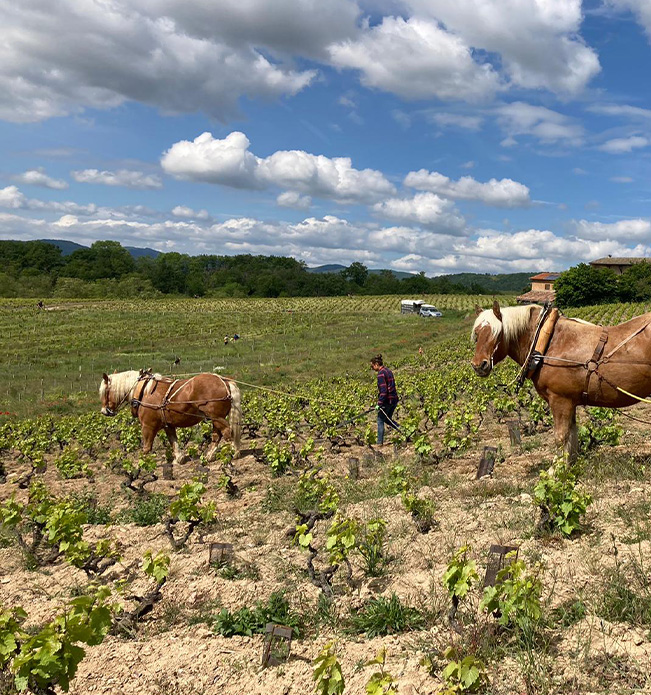
Plough horses “Pompom & Gingembre” working the rows
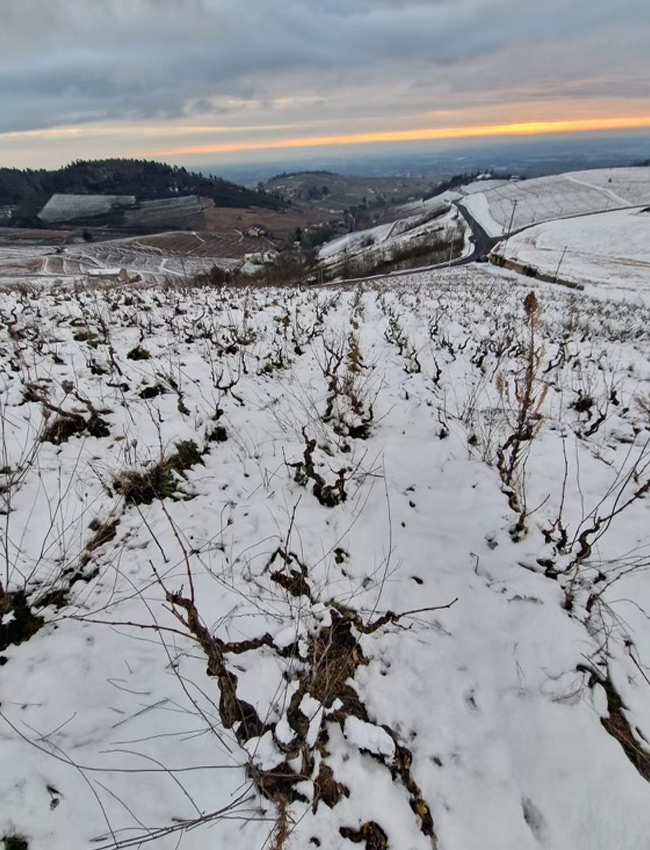
Snowy winter sunrise in my Fleurie vineyard
Location, Altitude & Microclimate
The rugged, windy hills of Morgon and Fleurie offer myriad microclimates and are sandwiched between the Massif Central mountains and the majestic Alps in central-eastern France. On clear days, we might glimpse the iconic Mont Blanc in the nearby Alps to the east. Burgundy’s Cote d’Or is just to our north.
One and a half hours from Paris on the 300 kph TGV, Morgon’s and Fleurie’s best vineyards are defined by a) high altitude, b) nutrient-poor granitic soils, c) old vines and d) diverse topography. This diverse topography of winding hills, small valleys and more suffers the “slings and arrows of outrageous fortune”; sleet, snow, hail, torrential rain, wind – and then glorious summer sunshine.
My Morgon “Bellevue” vineyard (beautiful view) is up at about 400 meters (1,310’) and my Fleurie “Fonfotin” vineyard even higher at 460 meters (1,510’). Both are high up on the westernmost section of the appellation, often seeing snow in winter. Meanwhile, Pauillac and Romanée-Conti bask in relative warmth at sea level.
Granite
Western Morgon and Fleurie soils are ancient, eroded, decomposed pink granite. It contains quartz and mica but it’s the feldspar that gives it its unique pink hue. Minerality anyone? Precipitation percolates quickly through these well-drained rocky soils, forcing roots to dig deeper. And remember, irrigation is illegal in France.
My vineyard profiles are predominantly:
• (Morgon) ancient deep pink granite
• (Fleurie) ancient shallow (eroded) pink granite
In 2008, local geologists began a decade-long research project to map every aspect of the region’s soils. In addition to thousands of field visits and analyses, over fifteen-thousand six-foot deep holes were dug, soils identified, and put into an expansive database. This hadn’t been attempted at this scale in any wine region in the world before this. Today their results show an unparalleled mosaic of soil diversity, one which winemakers could only dream about before, and which now a reality and helps all of us to make wines which express their terroir.
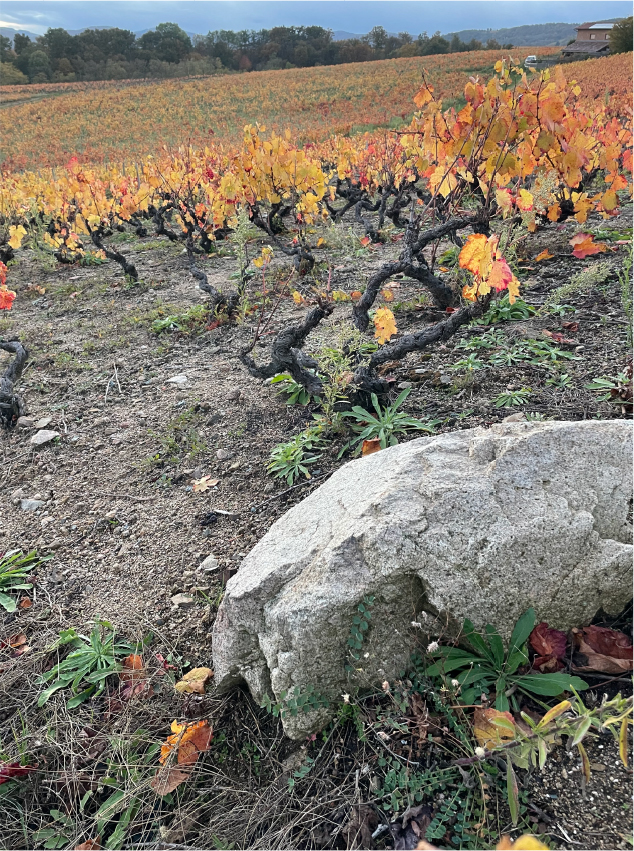
My 70 year-old Gamay Noir vines struggle in Morgon’s pink granite soil
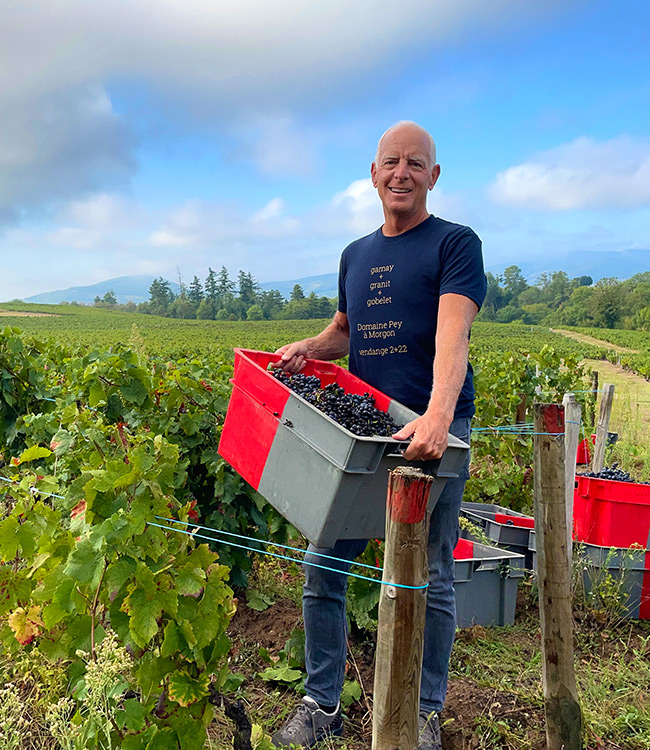
Hillside & High-Density Old Vines
The easternmost parcels in many “Cru” appellations tend to be flat and have more fertile, loamy soils. This allows for much easier mechanical farming and the rich, loamy soils give much higher yields. Accordingly, some of the wines from these eastern vineyards can be…ummm…rather ordinary and understandably less expensive. Conversely, my Morgon and Fleurie estate vineyards are perched on the high, westernmost hills with grades of 20% to over 40%, so we don’t need a Peloton for an ass-kicking workout. Worked manually, vine by vine, and at 10,000 vines per hectare in granite soils it is a challenging and expensive endeavor. But sturdy French plough horses don’t seem oblivious as they carefully navigate the tight spacing, steep rows, and rough granitic soils. And their organic by-products are welcome additions to our natural soil biomes.
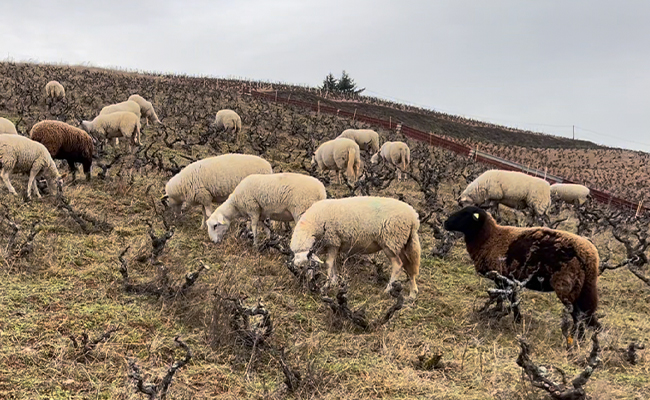
Sheep grazing in vineyard
Planted at about 10,000 vines/hectare, the vineyard density here is about 2.5x most Sonoma vineyards. Looking historic with their gnarled, twisted arms, at 70 years-old they were planted in 1953 when President Eisenhower (USA) and Auriol (France) were in office. These old vines could still remain productive for several decades. Gamay Noir vines are usually head-pruned “en gobelet” (looks like a gobelet) very low to the ground. They are a back-breaker to prune and to harvest.
Natural, Organic Farming
My Morgon and Fleurie “Cru” vineyards are certified as "transitioning to organic” which is a three-year process. Without toxic herbicides/fungicides and with very steep slopes I work my vineyards naturally – by hand - and more frequently. Natural organic farming costs about 25% more than “commercial” farming and my yields are lower because the vines aren’t jacked up with artificial chemicals. My decision to farm organically costs me more per hectare – and I get fewer grapes...hmmm. But it’s the right thing to do to make terroir-based wines.
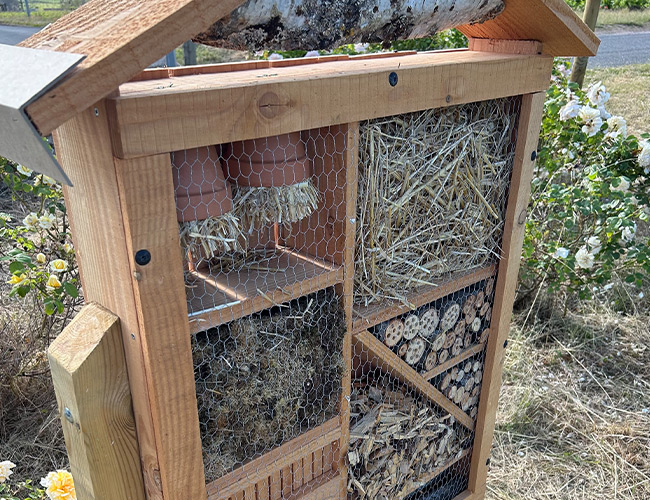
Our "bug hotels" enhance ecological diversity in my organic vineyards
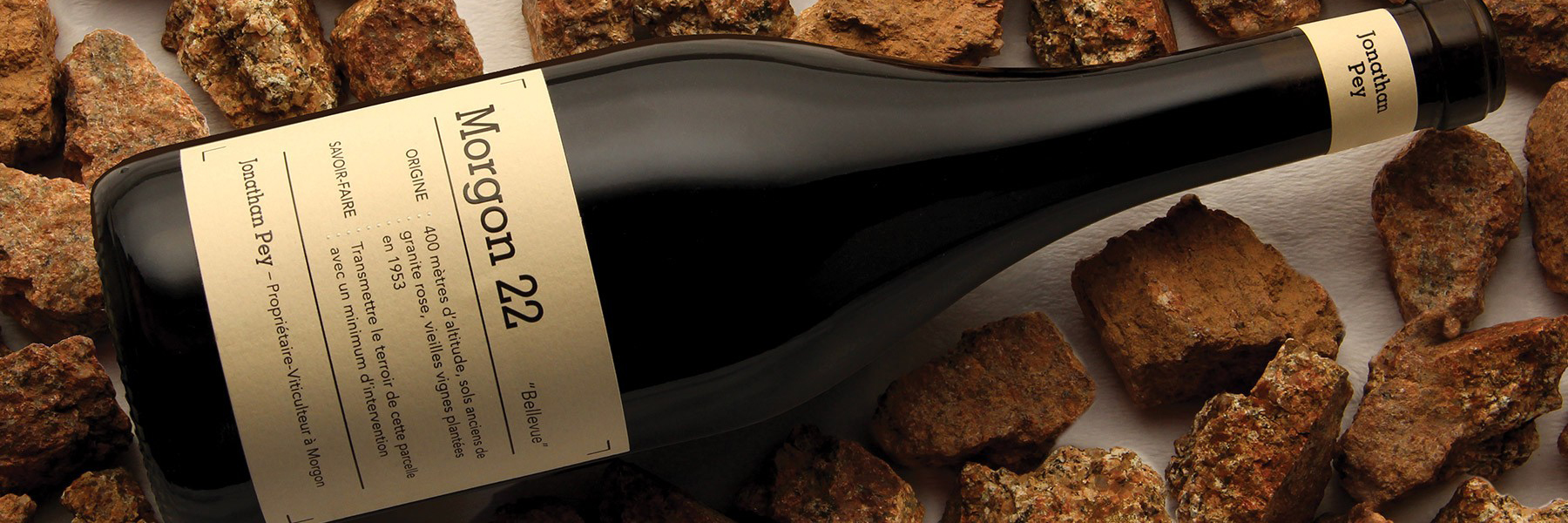
Selection Massale
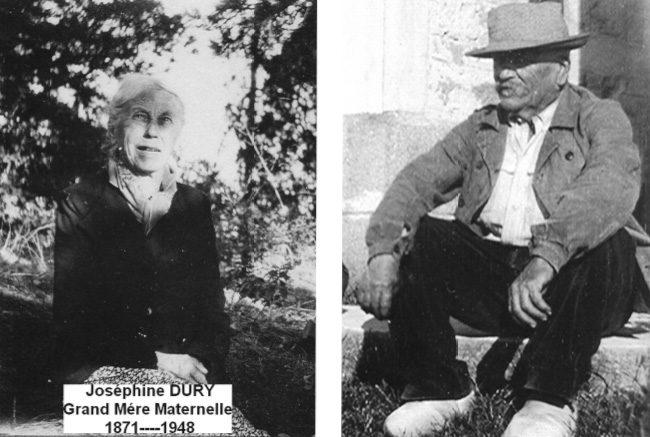
My Fleurie “Fonfotin” vineyard was established in the 1800’s by Joseph et Josephine Dury Dargaud (pictured above in the 1930’s), and recently run by their maternal great-granddaughter Collette Dubost Pignol and daughters.
The Pignol family leased it to the owners of the highly-regarded local pépinière (vine nursery), local experts in vine physiology, traits, natural propagation and more. All the best natural wine and other thoughtful local producers coveted their unique, historic “massale” vine cuttings. This is a hands-on, laborious, multi-year process "Selection Massale" is virtually unknown in California, which uses clonal propagation almost exclusively. Over two seasons the best buds are selected from the best vines in the best vineyards, propagated naturally, and then these diverse selections are re-planted.
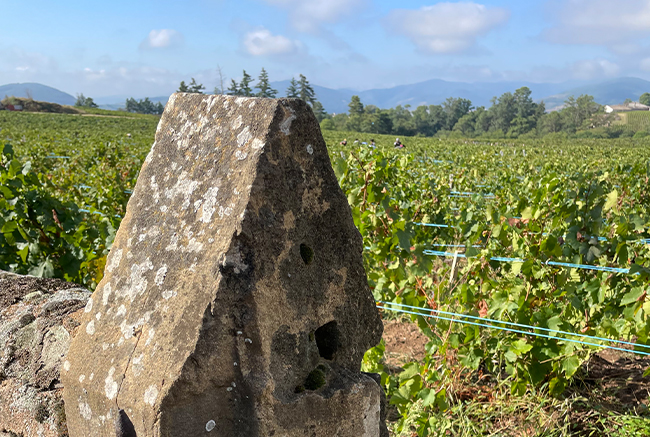
Meticulously selected, this historic vine material (rather than mass-produced uniform clones) was planted in my steep Fleurie “Fonfotin” site decades ago. This “Selection Massale” method preserves intra-varietal diversity. Think of it as a seed bank repository, but for natural, living grapevine budwood. Or think of it as selecting heritage vegetable seeds instead of Monsanto’s GMO seeds.
Vineyards curated by “Selection Massale” are the epitomy of “natural”, and yes, they tend to look a bit less uniform, and yields are lower. But the natural genetic diversity in my Fleurie vineyard, in addition to certified organic farming, adds unrivaled complexity to the wine in the glass. A true gem, what is in the glass is a historic treasure of what used to be and is extremely rare. Savor my Fleurie “Fontfotin", please.
What does “Cru” mean in Morgon and Fleurie?
The word “cru” in French translates to “growth” - as in a strictly defined vineyard area. In terms of what it means in these Appellations Protegée, it is more similar to the way Champagnes vineyards are classified than in Bordeaux.
A Cru in Morgon or Fleurie is a strictly-defined area that has been recognized by France’s governing body Institut National des Appellation d’Origine (INAO) for its unique and high-quality grapes and wines. The region has only ten “cru”. In Morgon’s case, it is the small area surrounding the village of Villié-Morgon, and in Fleurie it is around the village of Fleurie.
It includes not only specific limits of geography, but also a harvest maximum of 48 hectoliters per hectare. This converts to about only 3.1 tons per acre. Compare that to California’s statewide average of 6/tons acre and you see that it is a severely restricted maximum. In practice, the 48 HL/HA is rarely reached here; frost, hail and other weather events regularly knock it down below that. For example, in Vintage 2022 I got 25 hectoliters in Morgon. Ouch.
A Cru in Morgon or Fleurie also stipulates grape variety (Gamay Noir), minimum alcohol levels (10.5%), and any grape harvested in that cru must be fermented and bottled in the region (no shipping Cru Morgon or Fleurie grapes to Languedoc and bottling, for example). Last, Cru Morgon and Fleurie must pass a qualitative blind tasting.
In summary, a “Cru” is a legally-defined and regulated way to define terroir and to ensure that high-quality vineyard and cellar practices are being made so the wines produced express the very best of the small region. Good stuff.
Within the Cru Morgon area, even smaller sites, called “lieu-dits” further refine the terroir. (See my section on my Morgon vineyard in the “lieu-dit: of “Bellevue”).
“Lieu-Dit”
My Morgon and Fleurie estate vineyards also carry prestigious “lieu-dit” designations, specifically of Morgon “Bellevue” and Fleurie “Fonfotin”. First used in Gevrey-Chambertin in 640, a “lieu-dit” is so named because of unique and high-quality characteristics specific to that tiny piece of land; soil type, exposition/slope, and microclimate. Largely interchangeable with the Burgundian term “climat”, “lieu-dit” speaks to a vineyard parcel known for making distinct, high-quality wines of place. My “lieu-dit” vineyards of “Bellevue” and “Fonfotin” are sites well-known by Paris’s most in-the-know somms, but to date little-seen in North America.
